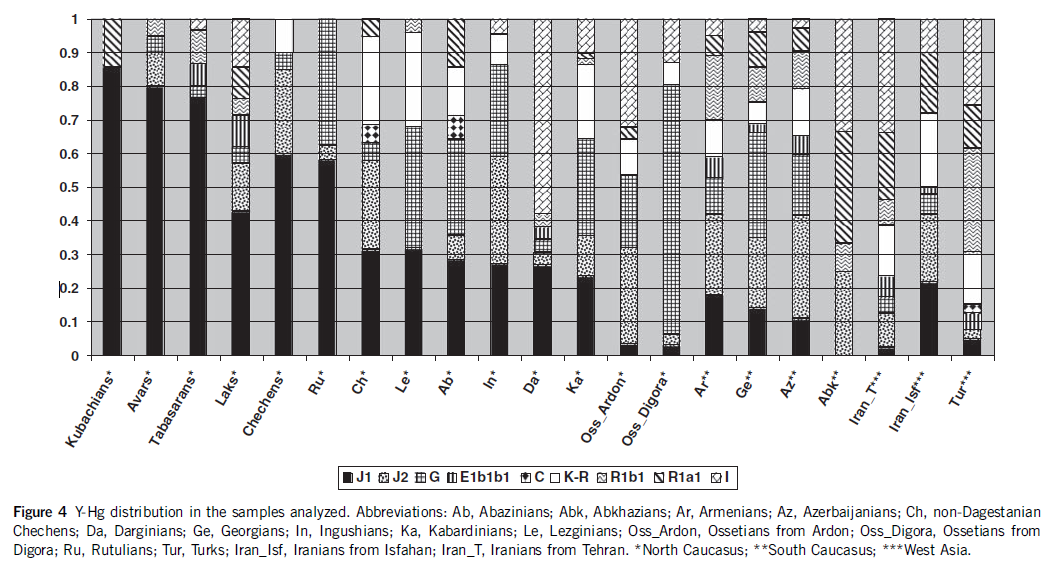Could you cite
any evidence that I2a1 is found in Armenia? It's the first time I hear this. From what I know, I2a1 is largely restricted to Western Europe, with the highest concentrations occuring in Sardinia and amongst the Basques.
Treilles is not the only Neolithic site. There is also Derenburg in Saxony-Anhalt, Germany.
http://www.plosbiology.org/article/info:doi/10.1371/journal.pbio.1000536
As I said, Treilles is a location where today ~70% of the population have R1b. What is the likelihood, if R1b was already present in that area in the Neolithic, that it turns up zero samples of R1b?
This German site also has almost exclusively Haplogroup G, and for a strange reason, Haplogroup F* (which is a tad surprising but shouldn't be too surprising). Again, this is an area which today has ~40% of the population as R1b. What is the likelihood, if R1b was already present in the Neolithic in Europe, for this site to turn up zero samples of R1b?
What is the likelihood of not one but two Neolithic sites turning up zero samples of R1b if it purportedly was already present and dominant. I would say VERY low.
The oldest site thus far which turned up R1b in Europe was Lichtenstein Cave in Lower Saxony, which belongs into the Urnfield Culture (circa 1000 BC).
This has two components: first off, I do believe that paleolithic Haplogroups
were preserved in France (9% I2a amongst the Basques certainly isn't a small value). Secondly, I do not believe that the present-day distributions and especially quantities of Haplogroup I were like this throughout the ages. Too much history happened in the meantime for this to work out, especially on the Balkans.
If you look into the Copper Age, you will notice that the
Corded Ware Culture did only expand into Central Europe and Scandinavia, but something prevented it from entering into Western Europe. This was the Beaker-Bell Culture, which was near-simultaneous with Corded Ware (though not in all areas). I should add that Corded Ware is already known to have been carriers of R1a (based on samples from Eulau, Germany, from circa 2600 BC).
In my opinion, the
Beaker-Bell Culture is the best candidate for explaining the spread of R1b. How did the Beaker culture arrive? Did they use airplanes?

I don't know (and I think they obviously didn't), but it's clear that the spread of R1b, more precisely the subclade
R1b-L51/M412 (which
includes Basque R1b) very much matches that of the Beaker Culture.
In any case it makes a lot sense if I2a1 was already in Europe since (at least) the Neolithic, and that the high concentrations of I2a1 on Sardinia are derived from the indigenous
Nuraghic civilization than from the Vandals who were Sardinia for less than a century.

I admit, I have no solution for this yet, but I promise I will give this some thought.
You are wrong about Hungarian. Where do you take from that it's Indo-European?!

etrified: Hungarian is an Uralic language family, but it belongs to a different branch than Finnish and Estonian. The Hungarians (or I should rather say, Magyars) originally lived at the southern edge of the Ural mountains until they migrated into the Pannonian basin circa 9th century AD. It's clear though if you look at modern-day Hungarian Haplogroups that the modern Hungarians are for the greater part descended from the pre-Magyar population that lived there before, because Hungarian Haplogroups are not terribly different from those found in surrounding areas.
This makes a huge point which people tend to forgot: you cannot make 1:1 assocations between languages or language families and haplogroups, and people can swap their languages over time, but they cannot swap their haplogroups.
Could you please show me where you read that. It's the first time I hear that. Besides, where would they come from? As I said, the only language that shows some potential relationship to Iberian is Basque (and the poorly attested Aquitanian language, which may be the same as Old Basque). The problem is that we know too little about Iberian to say if these are Basque borrowing into Iberian, Iberian borrowings into Basque, or that the two languages were part of the same language family. From what I know, the Iberians are generally believed to have their origin in the bronze age El-Argar culture of southeastern Spain.



 azimaBulayeva/Papers/125870/The_key_role_of_patrilineal_inheritance_in_shaping_the_genetic_variation_of_Dagestan_highlanders
azimaBulayeva/Papers/125870/The_key_role_of_patrilineal_inheritance_in_shaping_the_genetic_variation_of_Dagestan_highlanders